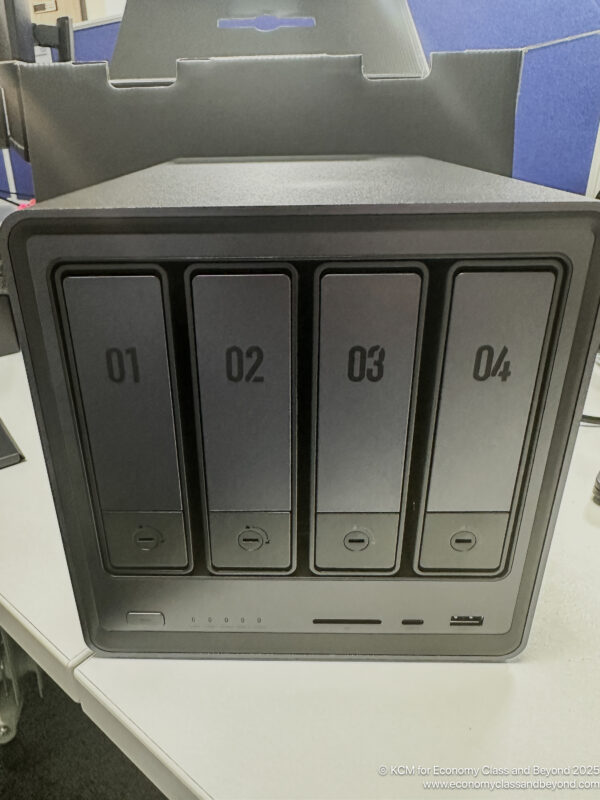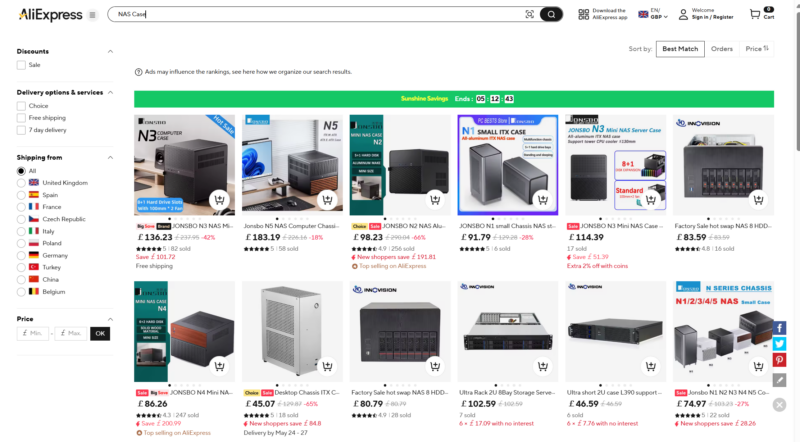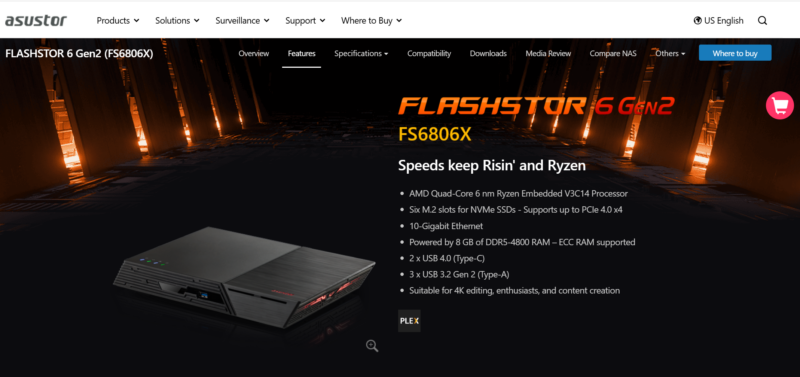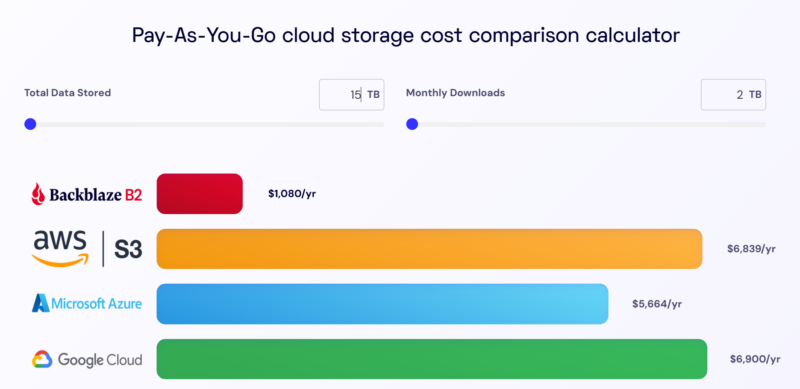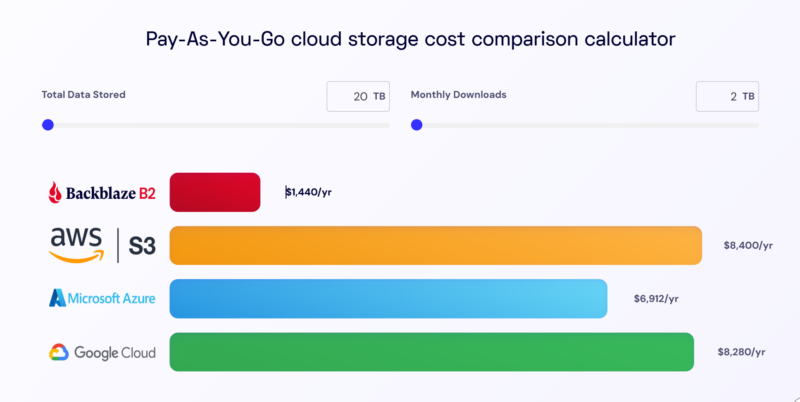TRAVEL TECHNOGLOGY: Data Storage Adventures – With a UGreen NASync DXP 4800
Part 1: Some Background and “Why Now?”
- Part 1: Some Background and “Why Now?”
- Part 2: Which NAS to go for? Some thoughts and design work
- Part 3: Building, Configuring and Deploying the UGreeen NASync DXP 4800
- Part 4: Data Transfer Tips and Tricks
- Part 5: Making this storage monster grow
- Part 6: Backups still matter, along with some more background reading
Time for another adventure into Data Storage. Join me as I navigate my way towards a new storage solution, as well as deploy it in the real world. This is a multi-part adventure, as there is a lot more than one post’s worth of content.
I make no apologies for going technical in this, as it becomes a technical subject fast. I’ll include links and videos for those who need to explore and learn, as well as a resources link at the end of this (because this thing is still being built at the time of writing).
Let’s go shopping for a storage box (or I think my Drobo Storage appliance is on its last legs)
Why are we here… again?
Putting my other hats on, I create a lot of images and some video content – some of which you see on this site, on my Instagram and other places. Some of it is commissioned content. And some have ended up on certain sites.
That data needs a home to go to, eventually, rather than being deleted and forgotten about.
And my data generation needs haven’t slowed down much, with at least 700 GB a year being generated (be it Camera RAW files, JPG and Films from the phone), with some years scaling a lot higher.
I left you dangling two years ago when I wrote about how Drobo left its customers (and me) in the lurch as their owner went out of business, as well as the next steps I was considering.
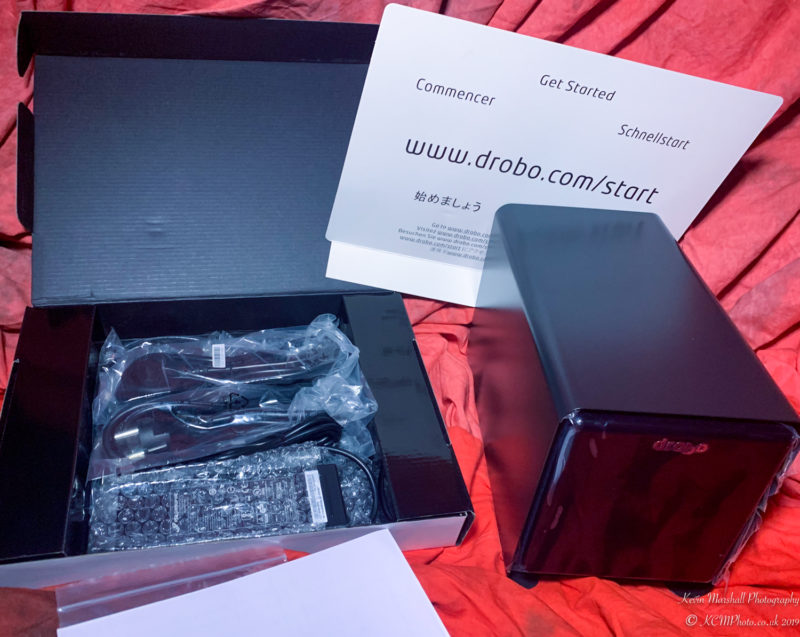
My Current Storage Solution – A Drobo 5D2N. You can read about my adventures with it here
Let’s go through some fundamentals, what’s happened since then… and why I’ve finally decided to make a move.
What’s a NAS?
A Network Attached Storage device allows you to consolidate data and host your own data (or cloud if you like), without having to subscribe to a hosting service.
You can also host various services on one (as the line between a NAS and a Server blurs by the day), with such options as PLEX, Home Assistant, Docker and so on being able to run on the device, freeing up capacity and processing power on your main computer.
There are various options in terms of configuration, be it desktop, rackmounted, and can contain from one disk to however many you can fit in a case.
Typically, these disks (providing there are more than two of them) can be set up in a RAID (Redundant Array of Inexpensive Disks) to allow for data protection in case a disk fails.
Although I’ll say this out loud (and multiple times), RAID is not a backup solution.
And remember to test your backups. A backup is worth nothing without testing to ensure it is readable on another device.
We’ve seen a lot of new entries since I wrote my “what’s next” article, with UGreen and Ubiqutiy entering the market (and that’s to name a few), whilst Asustor and Terramaster have made their own progressions.
For me, that’s both wonderful and a pain – there’s now more choice than ever. But more pain to go along with it, as I choose feature sets and such.
Even the DIY market is heating up, with interesting hardware from 45 Drives and the rise of HexOS (which is built on top of TrueNAS).
My Requirements
I might have “simple-seeming” requirements, but they help and guide the rest of my thinking, as well as helping manage my costs. For my deployment, I need:
- The most DIY I want to get is to put hard disks in caddies (and maybe screw in storage on a stick).
- Hot-swappable disks are a must (because when disks go wrong, fishing inside a computer case is not what I want to do, especially when I have to power down the device).
- Four Drive bays are wonderful. More bays are always better for expansion purposes.
- Able to handle the “big” disks we’re seeing today, with an eye on future expansion.
- I’m not keen on remote access (as I would prefer to keep the data inside the network), so whilst it’s offered, it’s not on my hot-list.
- Whilst the ability to load server applications is wonderful, it’s a nice-to-have, as opposed to a feature set.
I’ll be clear at this point- Your requirements will differ. Some of you will want a device to host videos and serve them around the home, some of you will want to run containerised applications (such as to run smart homes locally), and whatever you can think of.
I’m looking at this as an archival/retrieval system, not as a home server to rule everything (my extent of a smart home is two Apple HomePod Minis… and their primary purpose is to find my phone most of the time).
What’s being skipped in this build-out?
Let’s go and remove some things from this design and specification build-out, before we go much further.
A DIY NAS Build
In theory, it’s pretty simple. Find compatible components, put them in a case, strap them together, slap TrueNAS/UNRAID/HexOS on the thing and call it a day.
And in some ways, it’s a lot cheaper for the base hardware (Sans storage drives). Except we run into the fun of:
- Can the case hold the drives?
- Can I access the drives easily without getting the screwdriver out?
- Who is supporting this thing?
- Where is the hardware support, and how many vendors do I have to go to?
- What’s the learning curve for the software?
And there’s plenty of choices in cases…
And motherboards.
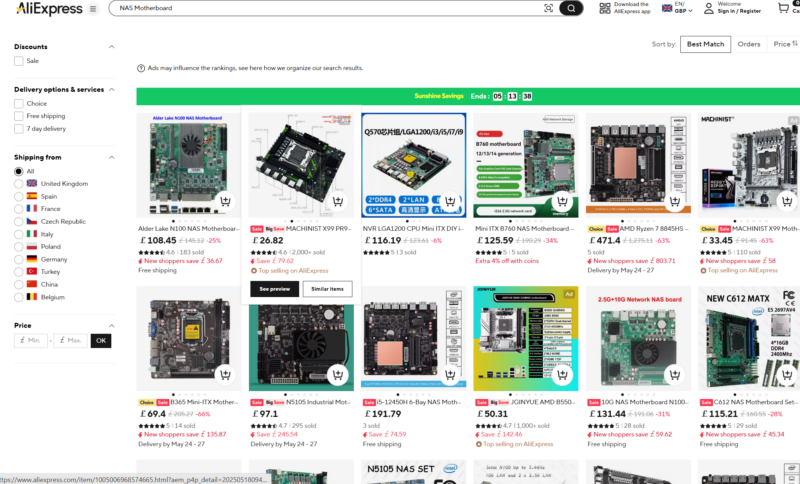
Data: AliExpress
When buying a turnkey solution, you’re throwing all those questions from many places down to two or three (be it the seller, the supplier and who provides your storage), as opposed to being your own support engineer and trying to diagnose where you went wrong (as well as know, companies love to not take blame until you give them proof).
And that’s time I can invest in using my hardware for its intended purpose, rather than make a homelab hodgepodge of hardware.
Don’t get me wrong – a homelab is a wonderful thing if you want to experiment, develop your skills and so on. But for a stable solution, I want something that just works out of the box.
Yes, I probably could lash together an AliExpress Motherboard with a CPU mounted on it, add a Host Bus Adaptor to have eight SATA Ports in a case which can hold the drives. But again, support becomes a nightmare.
Whilst I enjoy the role of being a support engineer, when I get home, I don’t want to be one fixing my own solutions when I get out of work.
I just want it to work.
Bad Synology. BAD!
Synology’s equipment was initially on the shopping list – not for its hardware, but its rather complete software suite and ease of use – but also for the ability to expand a disk storage system with different-sized units. This allows you to grow a storage solution as you go.
Those are things I like.
However, Synology have made ominous promises that their new series of hardware (and trust me – they haven’t released many upgrades since I looked in 2023) about not allowing (or heavily restricting) non-Synology drives, being unable to construct RAIDs without Synology flashed drives.
NAS Compares has gone through this at length.
Whilst closed ecosystems can have some benefits, hard disk drives are commodity hardware (and in this case, they’re rebadged drives with new firmware installed on them).
And it shouldn’t be a surprise, but Synology will charge you a markup for the privilege.
Sorry. For commodity hardware, I’m not playing that game.
If Synology wants to become the next NetApp, I’ve got no problem with that (with arrays that can drive a person mad if you’ve ever administered a cluster of the damn things). However, if they are targeting the Prosumer market (which their devices do), they’ve got to be better and allow openness.
A lot better.
You can find out a lot more at NASCompares.com.
Flash-Memory Storage NAS
If Flash was the saviour of The Universe and King of the Impossible, Flash Storage is extremely tempting with high bandwidth and fast read/write speeds (not for battling with Hawkmen, mind).
And it’s not as if companies have hung around since I wrote last, with Asustor, UGreen, QNAP offering Flash Storage servers (based on Non-Volatile Memory Express standard), with others like Minisfourms creating OS-Free options too.
And that’s wonderful, except we come up against the biggest issue with NVMe storage – cost.
If you’re sticking with “reliable” memory suppliers (eg Crucial, Kioxia, Lexar, Corsair, Western Digital/Sandisk… and if you’re thinking of using those 4Tb drives off Temu, just… don’t, you’re looking at £100 for 2 TB and £331 for 4 TB.

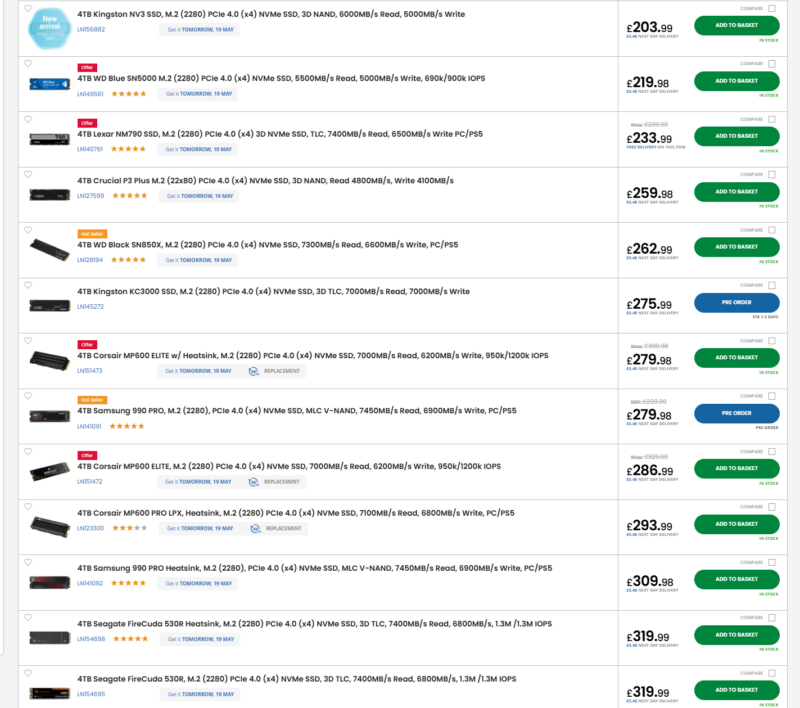
Pricing – Scan UK.
For £300 upwards, I can get a 16 TB spinning drive. And have plenty of change.
There are also plenty of compromises still, with the Asustor Flashstor Gen2 splitting its PCI Express lanes in a way that means you’ll need to create different storage pools with different drives to get the best out of it. Depending on the use case, that might be fine, but if you’re after one lump of fast storage, you may need to reevaluate your architectural decisions.
Some are still only scaling to 4 bays, whilst others are scaling to 12 bays. Again, the cost of NVMe solid state drives at the storage prices I need… gets stupid, fast.
Whilst an All-Flash memory array is still a wonderful thing that I might look to, memory prices need to plummet before I’ll seriously consider it for my use case.
Cloud Storage
On a month-by-month basis, Cloud storage might seem a bargain at the consumer level, after all you get 1TB/user with Office 365 for home for £90 a year.
But at Multi-Terrabyte scales, it becomes queasy, quickly. Basing the pricing of BlackBlaze B2 for a 15 TB instance (the size of a formatted disk, and my current storage settings). Note, these costs exclude any future rises, priced per year, with a 2 TB download limit.
Scaling to 20 Tb (which would allow for what I would consider generous growth over 2 years).
Scaling over 44 Tb (the size of a fully built storage unit with 4 x 16 Tb Drives)
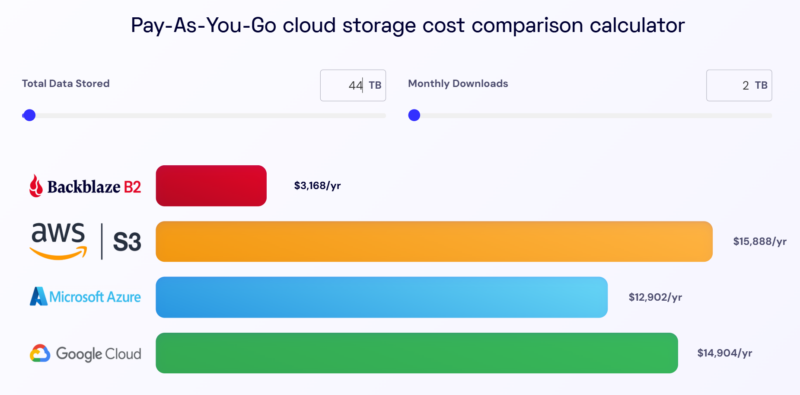
All numbers: Backblaze
There are other issues as well, including the time and bandwidth required to inject the data, and extracting the data if I ever want to leave a cloud solution.
That even in the 20 TB (middle growth scenario), I can recoup the cost of my NAS within a year. Even for a like for like data migration, its just over a year to recoup the cost.
Depending on the use case, Cloud Storage is not the solution; rather, it can be a heavy cost, with nasties in the future.
Other things we’re skipping
We’re skipping LTO Tape backups, 45 Drive Storinators (even their eight-bay version), RDX Drives, any server running Windows Server, and so on. My use case is still very much the same as when I built the Drobo initially. I just need to scale for larger storage.
So, Why Now?
I’ve been putting this off, as it is a £1500 investment, no matter which way I blink. The NAS Hardware itself will be one of the lower-cost parts. The more expensive part will be the storage disks.
If we go back to the Drobo, the server itself was £450. The 5 x 6Gb Disks came to £1000. It’s a big chunk of change when you’re trying to extract the best value out of your equipment.
I work with an equipment life span, with even NAS-rated disks having a limited life. I expect these disks have a 5-year operational life or so before I expect serious problems.
Considering I’m in 2025 and starting to replace the device (and the original device was commissioned in 2019), I’m cutting it close before I expect failures (and these drives have been on 24/7).
The final thing that made me consider this migration is that the Drobo’s software has slowly been degrading.
With either a MacOS update or an internal fault, the Drobo isn’t communicating with the network and clients correctly, which accelerates matters for a replacement.
Remember, in this view, hardware is cheap. Memories and data are a lot harder to replace.
At least the Network Shares that I created are accessible by both Windows and Mac Clients on the Drobo. That makes things passable, if not ideal.
But enough of a warning shot to start planning an evacuation off the Drobo.
Next:
Let’s go shopping for a NAS.
Welcome to Economy Class and Beyond. Your no-nonsense guide to network news, honest reviews, in-depth coverage, unique research, as well as the humour and madness I only know how to deliver.
Our Social Media pool has expanded. You can find us across most networks as @economybeyond on BlueSky, Threads, Mastodon and Instagram!
Also, remember that we are part of the BoardingArea community, bringing you the latest frequent flyer news from around the world.
